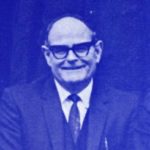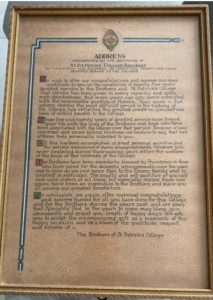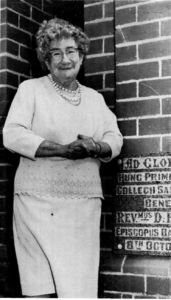Matron’s role with family ties spanning over half a century
August 4, 2021
We thank Old Collegian, former staff member and honoured SPC Facere et Docere recipient Michael Brady (SPC 1956-62, PY1963) for piercing together this rich history of family ties to St Patrick’s College, spanning more than half a century.
A FAMILY AFFAIR
Part One – 1918 -1947
When Kate (1918) and Dorrie (1922) Emery commenced work at St Patrick’s College, never in their wildest dreams would they have imagined that that would be the start of a family association with the College that would endure for over 50 years. Initially Dorrie worked in the College laundry, then a little later on to duties in the kitchen with Kate. Kate left the College in 1923 to be married and for the following 20 years raised a family of eight under tough circumstances as she was widowed in 1943. Meanwhile, Dorrie carried on with domestic chores such as preparing for meals, making boarders beds, washing dishes etc.
In the early 30’s work commenced on the construction of the beautiful brother’s house and a new administration area. This complex also included a brand-new kitchen with all the ‘mod-cons’ to be able the better serve the growing number of boarders. However, as fickle as boarding numbers could be, along comes a world-wide depression topped off with prolonged drought in the farming areas that the College had come to rely on. The effect was devastating and it took many years to recover. No more bed making, no more dishwashing for the maids because the boarders now had to do those chores.
In 1938, Dorrie was asked to take on the position of Matron. This was no easy task as she had witnessed previously but she acquiesced. Her position now was such she was answerable only to the headmaster. She was responsible for ALL things domestic and also worked with the College residential nurse to monitor the health of her young charges.
These duties also had to be tended to the brothers. In earlier times there were 21 brothers in the Community made up of 11 or 12 teaching at St Pat’s and three or four at each of St Patrick’s Drummond, St Aloysius and St Paul’s Technical School – these brothers needed a cut lunch to accompany them on their bike ride to school early in the mornings.
All the tricks of the trade had to be employed when World War II broke out. By 1942, Darwin had been bombed by the Japanese, mini-subs had entered Sydney harbour and unidentified shipping had been sighted in Bass Strait. All of this caused alarm and unprecedented demand from Melbourne parents for boarding in order to guarantee safety for their children. Thus, the numbers in boarding rose from a manageable 193 in 1942 to 260 in 1944. Learn how the war impacted on SPC in this story here
Also documented were health issues to be dealt with at this time. Boarders became ill as well as some of the brothers, further complicating things. Overcrowding was rife and resources scant. More pressure.
Mention was made earlier of the ‘family affair’. As well as Dorrie and Kate there were other Emery sisters who worked at the College. Johanna Stringer (and later her daughter, Yvonne), Vera Donnelly and Mollie were mentioned but details of their employment are not recorded anywhere to be found. Vera was the mother of Leo Donnelly who did all of his schooling at St Pats (40-50) and was ordained in 1957 as a Columban Missionary, spending most of his life working in Peru.

Tom Halliburton.
In 1946, Dorrie married Tom Halliburton, and this signalled Matron’s retirement to deal with domestic and maternal duties of her own. Tom was one of the few lay teachers at the College at the time. He served two separate employment periods, 1941-1954, 1963-1971. He was heralded as a very good teacher, both in the primary and junior secondary areas and assisted with the cadets, holding the rank of Officer Commanding. The time in between these dates were spent as an accountant at the Wallace Butter Factory.

Kiernan Halliburton, pictured in his Form 6 class photograph in 1970, has the distinction of being the longest attendee at the College – 1958-1970 – a record that will never be broken.
This union of Tom and Dorrie bore fruit with the birth of three sons – Leon, Denis and Kiernan, all of whom attended their primary and secondary schooling at the College. Kiernan has the distinction of being the longest attendee at the College – 1958-1970 – a record that will never be broken. His son, Nicholas, also attended the College. (SPC 1990, PY1995)
Back to Dorrie. “In December 1947 the Brothers gave a dinner in Matron’s honour. At the dinner were her parents, brothers and sisters, nephews and nieces and the community of St Patrick’s (Brothers). During the dinner the Brothers presented Matron with a gold wristlet watch to mark the completion of her 25th year at the College”.
Also, at this time, Dorrie was also given a mounted plaque detailing the respect and esteem with which she was held. Dorrie retired in 1947.

The plaque, presented to Dorrie Halliburton (nee Emery) when she retired from SPC in 1947, detailing the respect and esteem with which she was held by the Christian Brothers of the time.
A FAMILY AFFAIR
Part Two – 1947-1971
Previously we looked at the impact that Dorrie and other Emery family members had on the boarding at the College. Now we look at the era of Matron Brady.

Matron (Kate) Brady (nee Emery).
Dorrie retired as Matron in 1947. Br Healy was anxious to have a successor who he could rely on and trust implicitly. That was an easy choice. Kate had returned to the College community in 1943 after the death of her husband, Peter Brady and taken up residency in the former farmer’s house situated on the far southern corner of the property. This was a very long, healthy walk to the kitchen, in all the challenging weathers that Ballarat has to offer, done 7 days a week for 27 years.

The old chapel, which was used to house boarders at one point.
Kate took the reins in a period of rapid growth for the College. The war had ended, the farmers were working their way-out of their disastrous drought years and the “baby boomers” were starting to make their presence felt. Numbers grew before suitable accommodation could be provided. The huge debt for the Chapel still remained so building new classrooms or dormitories was out of the question. Hence gross overcrowding in dormitories and classrooms. In fact, one form one class had 95 students, mostly boarders, housed in the old chapel!!
This naturally impacted on the kitchen’s capabilities. The eastern wing of the old Holy Ghost wing became a dining room which had to house 312 boarders. This was not at all desirable. The food had to be basic and the menu predictable. The domestic staff were under a great deal of pressure and Matron had to deal with the onerous task that all this involved. A severe trial was to come.
In 1957 a flu epidemic descended upon community in the first term only to be followed by the more serious Asian flu in the second term. Maids and brothers became nurses and one dormitory became a hospital to try to stem the infection. Eventually, things returned to normal but the experience had left its scars.

Mr Joe Phyland, who was chef at SPC between 1963-1992.
It was not until 1961-2 that the kitchen and dining room took on a new perspective. An extension to the old dining room running east west was added and this brought some civility and a homelier atmosphere. Toast appeared on the menu and sometimes the hint of an egg. As well, Mr Joe Phyland was employed as chef, which took some of the burden from the Matron.

The new Dining Room, pictured in 1962, as published in the History and Heritage 1893-1993 book.
Steadily the number of boarders decreased through a conscious decision of Br Murphy (1961-3). Melbourne applications were discouraged as there were ample opportunities for Catholic education in the city. This allowed for more amenable accommodation to be provided. Domestic staff had fewer demanding tasks which allowed Matron to ease off her duties and take on semi-retirement.
And so, it was that in 1969, Kate retired with this glowing tribute;
“Brothers, including succeeding Headmasters, who relied on her and were never let down; members of the domestic staff who found her sympathetic and understanding; tradesmen who got to know what as required in the way of quality and price; and above all the boarders who knew what while they were temporarily away from their own mothers there was a lady with a mothers heart who had their interests as if they were her own.”
One of the tributes to Kate, which has long gone missing, was the naming of a tinnie (motor boat) used for the rowing, in her honour. This was done in recognition of all the extra work that had to be done to accommodate extra meal times for the rowers who were limited to training times before and after school. Boarders lunches etc, had to be prepared if regattas were away from Ballarat. This boat was destroyed in the arson attack on the boat shed in 1967.
Matron Brady retired to live her remaining days in the cottage on the Shed oval. Within two years both Tom and Kiernan had moved away from the College, signalling the end of an era spanning the years 1918-1971. Matron died in 1974 at the age of 82.
Sources: History and Heritage by Br P.C. Naughtin 1993, Sharon McCarty (granddaughter of Kate), Dr Kiernan Halliburton, Leon Halliburton (sons).
